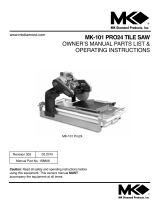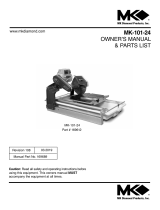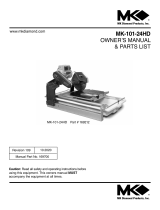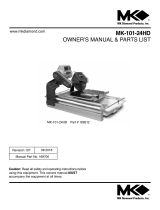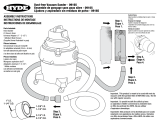Page is loading ...

General Safety Rules
WARNING: Read and understand all instructions. Failure to follow all instructions listed
below may result in electric shock, fire and/or serious personal injury.
SAVE THESE INSTRUCTIONS
Work Area
• Keep your work area clean and well lit. Cluttered benches and dark areas invite
accidents.
• Do not operate power tools in explosive atmospheres, such as in the presence of
flammable liquids, gases, or dust. Power tools create sparks which may ignite the dust
or fumes.
• Keep bystanders, children, and visitors away while operating a power tool.
Distractions can cause you to lose control.
Electrical Safety
• Double insulated tools are equipped with a polarized plug (one blade is wider than
the other). This plug will fit in a polarized outlet only one way. If the plug does not fit
fully in the outlet, reverse the plug. If it still does not fit, contact a qualified
electrician to install a polarized outlet. Do not change the plug in any way. Double
insulation eliminates the need for the three wire grounded power cord and grounded
power supply system.
• Avoid body contact with grounded surfaces such as pipes, radiators, ranges and
refrigerators. There is an increased risk of electric shock if your body is grounded.
• Don’t expose power tools to rain or wet conditions. Water entering a power tool will
increase the risk of electric shock.
• Do not abuse the cord. Never use the cord to carry the tools or pull the plug from an
outlet. Keep cord away from heat, oil, sharp edges or moving parts. Replace
damaged cords immediately. Damaged cords increase the risk of electric shock.
• When operating a power tool outside, use an outdoor extension cord marked "W-A"
or "W". These cords are rated for outdoor use and reduce the risk of electric shock.
Personal Safety
• Stay alert, watch what you are doing and use common sense when operating a
power tool. Do not use tool while tired or under the influence of drugs, alcohol, or
medication. A moment of inattention while operating power tools may result in serious
personal injury.
• Dress properly. Do not wear loose clothing or jewelry. Contain long hair. Keep your
hair, clothing, and gloves away from moving parts. Loose clothing, jewelry, or long hair
can be caught in moving parts. Air vents may cover moving parts and should be avoided.
• Avoid accidental starting. Be sure switch is off before plugging in. Carrying tools with
your finger on the switch or plugging in tools that have the switch on invites accidents.
• Remove adjusting keys or wrenches before turning the tool on. A wrench or key that is
left attached to a rotating part of the tool may result in personal injury.
• Do not overreach. Keep proper footing and balance at all times. Proper footing and
balance enables better control of the tool in unexpected situations.
• Use safety equipment. Always wear eye protection. Dust mask, non-skid safety shoes,
hard hat, or hearing protection must be used for appropriate conditions.
Tool Use and Care
• Use clamps or other practical way to secure and support the workpiece to a stable
platform. Holding the work by hand or against your body is unstable and may lead to loss
of control.
• Do not force tool. Use the correct tool for your application. The correct tool will do the
job better and safer at the rate for which it is designed.
• Do not use tool if switch does not turn it on or off. Any tool that cannot be controlled
with the switch is dangerous and must be repaired.
• Disconnect the plug from the power source before making any adjustments,
changing accessories, or storing the tool. Such preventative safety measures reduce
the risk of starting the tool accidentally.
• Store idle tools out of reach of children and other untrained persons. Tools are
dangerous in the hands of untrained users.
• Maintain tools with care. Keep cutting tools sharp and clean. Properly maintained
tools, with sharp cutting edges are less likely to bind and are easier to control.
• Check for misalignment or binding of moving parts, breakage of parts, and any other
condition that may affect the tools operation. If damaged, have the tool serviced
before using. Many accidents are caused by poorly maintained tools.
• Use only accessories that are recommended by the manufacturer for your model.
Accessories that may be suitable for one tool, may become hazardous when used on
another tool.
Service
• Tool service must be performed only by qualified repair personnel. Service or
maintenance performed by unqualified personnel could result in a risk of injury.
• When servicing a tool, use only identical replacement parts. Follow instructions in
the Maintenance section of this manual. Use of unauthorized parts or failure to follow
Maintenance Instructions may create a risk of electric shock or injury.
WARNING: Some dust created by power sanding, sawing, grinding, drilling, and
other construction activities contains chemicals known to cause cancer, birth defects
or other reproductive harm. Some examples of these chemicals are:
• lead from lead-based paints,
• crystalline silica from bricks and cement and other masonry products, and
• arsenic and chromium from chemically-treated lumber (CCA).
Your risk from these exposures varies, depending on how often you do this type of work. To
reduce your exposure to these chemicals: work in a well ventilated area, and work with
approved safety equipment, such as those dust masks that are specially designed to filter out
microscopic particles.
• Avoid prolonged contact with dust from power sanding, sawing, grinding, drilling, and
other construction activities. Wear protective clothing and wash exposed areas with
soap and water. Allowing dust to get into your mouth, eyes, or lay on the skin may promote
absorption of harmful chemicals.
WARNING: Use of this tool can generate and/or disburse dust, which may cause
serious and permanent respiratory or other injury. Always use NIOSH/OSHA approved
respiratory protection appropriate for the dust exposure. Direct particles away from face and
body.
CAUTION: Wear appropriate hearing protection during use. Under some conditions
and duration of use, noise from this product may contribute to hearing loss.
First Aid Measures for Gel Components
If gel within the comfort grip becomes exposed and results in skin contact wash with soap
and water; For eye contact, flush with flowing water. If swallowed, seek medical attention.
Material Safety Data Sheet (MSDS) available from 1-800-544-6986
The label on your tool may include the following symbols.
V ..........................volts A..........................amperes
Hz ........................hertz W ........................watts
min........................minutes ......................alternating current
......................direct current
n
o ........................no load speed
..........................
Class II Construction
........................earthing terminal
........................safety alert symbol .../min ..................revolutions or
reciprocations
per minute
Cat. No. FS3000ROS Form No. 492310-00
Copyright © 2005 Black & Decker Printed in China (DEC. ‘05)
KEY INFORMATION YOU SHOULD
KNOW:
• Never operate the sander without
recommended sandpaper properly installed
on the base.
• Do not push down—let the sander do the
work.
• Extended drywall sanding is not
recommended.
VEA EL ESPAÑOL EN LA CONTRAPORTADA.
SAVE THIS MANUAL FOR FUTURE REFERENCE.
INSTRUCTIVO DE OPERACIÓN, CENTROS DE SERVICIO Y
PÓLIZA DE GARANTÍA. ADVERTENCIA: LÉASE ESTE
INSTRUCTIVO ANTES DE USAR EL PRODUCTO.
INSTRUCTION MANUAL
RR
RR
aa
aa
nn
nn
dd
dd
oo
oo
mm
mm
OO
OO
rr
rr
bb
bb
ii
ii
tt
tt
SS
SS
aa
aa
nn
nn
dd
dd
ee
ee
rr
rr
Safety Warnings and Instructions: Sanders
• ALWAYS WEAR EYE AND RESPIRATORY PROTECTION.
• Clean your tool out periodically.
Other Important Safety Warnings and Instructions
Extension Cords
When using an extension cord, be sure to use one heavy enough to carry the current your
product will draw. An undersized cord will cause a drop in line voltage resulting in loss of
power and overheating. The following table shows the correct size to use depending on cord
length and nameplate ampere rating. If in doubt, use the next heavier gage. The smaller the
gage number, the heavier the cord.
1
BEFORE RETURNING THIS PRODUCT
FOR ANY REASON PLEASE CALL
1-800-544-6986
IF YOU SHOULD HAVE A QUESTION OR
EXPERIENCE A PROBLEM WITH YOUR
BLACK & DECKER PRODUCT,
CALL 1-800-544-6986
BEFORE YOU CALL, HAVE THE FOLLOWING INFORMATION AVAILABLE, CATALOG No., TYPE
No., AND DATE CODE (e.g. 0130M). IN MOST CASES, A BLACK & DECKER REPRESENTATIVE
CAN RESOLVE YOUR PROBLEM OVER THE PHONE. IF YOU HAVE A SUGGESTION OR
COMMENT, GIVE US A CALL. YOUR FEEDBACK IS VITAL TO BLACK & DECKER.
2
Catalog No. FS3000ROS
3
4
6
5
Minimum Gage for Cord Sets
Volts Total Length of Cord in Feet
120V 0-25 26-50 51-100 101-150
240V 0-50 51-100 101-200 201-300
Ampere Rating
More Not more American Wire Gage
Than Than
0-6 18 16 16 14
6 - 10 18 16 14 12
10 - 12 16 16 14 12
12 - 16 14 12 Not Recommended

AVERTISSEMENT : IMPORTANTES MESURES DE SÉCURITÉ
AVERTISSEMENT! Vous devez lire et comprendre toutes les instructions. Le
non-respect, même partiel, des instructions ci-après entraîne un risque de choc électrique,
d’incendie et/ou de blessures graves.
CONSERVEZ CES INSTRUCTIONS.
Zone de travail
• S'assurer que la zone de travail est propre et bien éclairée. Des établis encombrés et
des endroits sombres présentent des risques d'accidents.
• Ne pas utiliser des outils électriques en présence de vapeurs explosives (comme
celles dégagées par des liquides, des gaz ou des poussières inflammables). Les
étincelles générées par le moteur des outils électriques peuvent enflammer les poussières
ou les vapeurs.
• Éloigner les curieux, les enfants et les visiteurs de la zone de travail lorsqu'on utilise
un outil électrique. Une distraction peut entraîner la perte de maîtrise de l'outil.
Mesures de sécurité relatives à l’electricite
• Les outils à double isolation comportent une fiche polarisée (une lame plus large que
l'autre). La fiche n'entre que d'une façon dans une prise polarisée. Lorsque la fiche
n'entre pas à fond dans la prise, essayer de nouveau après avoir inversé les broches
de la fiche. Si la fiche n'entre toujours pas dans la prise, communiquer avec un
électricien certifié afin de faire installer une prise polarisée. Ne modifier en aucune
façon la fiche. La double isolation élimine le besoin d'un cordon trifilaire mis à la terre et
d'un système d'alimentation mis à la terre. Valable
seulement pour les outils de classe II (à double isolation).
• Éviter de toucher à des surfaces mises à la terre comme des tuyaux, des radiateurs,
des cuisinières et des réfrigérateurs. Les risques de secousses électriques sont plus
élevés si le corps de l'utilisateur est mis à la terre.
• Protéger les outils électriques de la pluie ou des conditions mouillées. Une infiltration
d'eau dans l'outil augmente les risques de secousses électriques.
• Manipuler le cordon avec soin. Ne jamais se servir du cordon afin de transporter
l'outil ni tirer sur le cordon pour débrancher l'outil. Éloigner le cordon des sources de
chaleur, des flaques d'huile, des arêtes tranchantes et des pièces mobiles.
Remplacer immédiatement les cordons endommagés. Les cordons endommagés
augmentent les risques de secousses électriques.
• Lorsqu'on utilise un outil électrique à l'extérieur, se servir d'un cordon de rallonge
prévu pour l'extérieur, portant la mention «W-A» ou «W». Ces cordons sont conçus pour
servir à l'extérieur et minimisent les risques de secousses électriques.
Sécurité personnelle
• Demeurer vigilant, prendre soin et faire preuve de jugement lorsqu'on utilise un outil
électrique. Ne pas s'en servir lorsqu'on est fatigué ou affaibli par des drogues, de
l'alcool ou des médicaments. De graves blessures peuvent résulter d'un moment
d'inattention lors de l'utilisation d'un outil électrique.
• Porter des vêtements appropriés. Ne pas porter des vêtements amples ou des bijoux.
Couvrir ou attacher les cheveux longs. Garder les cheveux, les vêtements, les bijoux
et les gants éloignés des pièces mobiles, car ceux-ci peuvent s’y coincer. Se tenir
éloigné des évents puisque ces derniers pourraient camoufler des pièces mobiles.
• Éviter les démarrages accidentels. S'assurer que l'interrupteur est en position hors
tension avant de brancher l'outil. Afin d'éviter les risques de blessures, ne pas transporter
l'outil avec le doigt sur l'interrupteur ni brancher un outil dont l'interrupteur est en position
sous tension.
• Enlever les clés de réglage avant de mettre l'outil sous tension. Une clé qui est laissée
sur une pièce rotative de l'outil présente des risques de blessures.
• Ne pas dépasser sa portée. Garder son équilibre en tout temps. On s'assure d'une
meilleure maîtrise de l'outil dans des situations imprévues grâce à une position stable et un
bon équilibre.
• Porter de l'équipement de sécurité. Toujours porter des lunettes de sécurité. Dans
certaines conditions, il faut porter des masques respiratoires, des chaussures
antidérapantes, un casque de sécurité ou des protège-tympans.
Utilisation et entretien de l’outil
• Fixer et soutenir la pièce sur une plate-forme stable au moyen d’une bride de serrage
ou de tout autre dispositif semblable. La pièce est instable lorsqu’on la retient
manuellement ou qu’on l’appuie contre le corps, ce qui pourrait faire perdre la maîtrise de
l’outil.
• Ne pas forcer l’outil ni l’utiliser pour des travaux autres que ceux pour lesquels il a été
conçu. Pour obtenir de meilleurs résultats et prévenir les risques de blessure, laisser l’outil
couper à la vitesse pour laquelle il a été conçu.
• Ne pas se servir de l'outil lorsque l'interrupteur est défectueux. Le cas échéant, l'outil
est dangereux et il faut le réparer.
• Débrancher l'outil de la source d'alimentation avant de le régler, d'en remplacer les
accessoires ou de le ranger. On minimise de la sorte le risque de démarrage accidentel
de l'outil.
• Ranger l'outil hors de portée des enfants et de toute autre personne qui n'en connaît
pas le fonctionnement. L'outil est dangereux entre les mains de ces personnes.
• Prendre soin des outils. S'assurer que les outils de coupe sont tranchants et propres.
Des outils bien entretenus à arêtes tranchantes ont moins tendance à se coincer et ils se
maîtrisent mieux.
• Vérifier l'alignement et les attaches des pièces mobiles, le degré d'usure des pièces
ainsi que tout autre facteur susceptible de nuire au bon fonctionnement de l'outil.
Sanding
Lead based Paint
Sanding of lead based paint is NOT RECOMMENDED due to the difficulty of controlling the
contaminated dust. The greatest danger of lead poisoning is to children and pregnant
women.
Since it is difficult to identify whether or not a paint contains lead without a chemical analysis,
we recommend the following precautions when sanding any paint:
Personal Safety
• No children or pregnant women should enter the work area where the paint sanding is
being done until all clean up is completed.
• A dust mask or respirator should be worn by all persons entering the work area. The filter
should be replaced daily or whenever the wearer has difficulty breathing.
NOTE: Only those dust masks suitable for working with lead paint dust and fumes should
be used. Ordinary painting masks do not offer this protection. See your local hardware
dealer for the proper (NIOSH approved) mask.
• NO EATING, DRINKING or SMOKING should be done in the work area to prevent
ingesting contaminated paint particles. Workers should wash and clean up BEFORE
eating, drinking or smoking. Articles of food, drink, or smoking should not be left in the work
area where dust would settle on them.
Environmental Safety
• Paint should be removed in such a manner as to minimize the amount of dust generated.
• Areas where paint removal is occurring should be sealed with plastic sheeting of 4 mils
thickness.
• Sanding should be done in a manner to reduce tracking of paint dust outside the work
area.
Cleaning and Disposal
• All surfaces in the work area should be vacuumed and thoroughly cleaned daily for the
duration of the sanding project. Vacuum filter bags should be changed frequently.
• Plastic drop cloths should be gathered up and disposed of along with any dust chips or
other removal debris. They should be placed in sealed refuse receptacles and disposed of
through regular trash pick-up procedures. During clean up, children and pregnant women
should be kept away from the immediate work area.
• All toys, washable furniture and utensils used by children should be washed thoroughly
before being used again.
Motor
Be sure your power supply agrees with nameplate marking. 120 Volts AC only means your
tool will operate on standard 60 Hz household power. Do not operate AC tools on DC. A
rating of 120 volts AC/DC means that you tool will operate on standard 60 Hz AC or DC
power. This information is printed on the nameplate. Lower voltage will cause loss of power
and can result in over-heating. All Black & Decker tools are factory-tested; if this tool does
not operate, check the power supply.
Operating Instructions
WARNING: Always unplug sander from power supply before any of the following
operations.
WARNING: To reduce the risk of serious personal injury, read, understand and follow all
important safety warnings and instructions prior to using this tool.
Attaching Sandpaper
To attach sandpaper, carefully center the cloth side of the paper over the sanding pad. Press
the paper firmly in place. The hook and loop paper can be removed by simply pulling it off.
Switch - Figure 1
To turn the tool ON, push the portion of the dust protected switch marked "I". To turn the tool
OFF, push the portion of the switch marked "O".
Holding the Sander - Figures 2, 3, 4
The design of the Random Orbit Sander allows for several different gripping methods. Three
basic methods are:
Figure 2 - One handed operation on the top of the sander.
Figure 3 - One handed operation holding the body of the sander.
Figure 4 - Two handed operation with one hand on the jug handle and the other on the body
or the top of the sander.
Operation
Grasp the sander and turn it ON. Move it in long, sweeping strokes along the surface, letting
it do the work. Utilize an even pressure across the sanding pad. Excessive pressure in the
corner area may cause damage. Pushing down on the tool while sanding actually slows the
removal rate and produces an inferior quality finish. Check your work often. Sander is
capable of removing material rapidly.
Dust Extraction - Figure 5, 6
WARNING: Collected sanding dust from sanding surface coatings (polyurethane,
linseed oil, etc.) can self-ignite in sander dust bag or elsewhere and cause fire. To
reduce risk, empty bag frequently and strictly follow sander manual and coating
manufacturer's instructions.
Your sander comes equipped with a cloth dustbag to collect the dust generated while
sanding. To attach the dustbag onto the sander simply slide it firmly into the dust extraction
port at the back of the sander.
To empty the dust dustbag, remove it from the sander by pulling it straight back. Dump the
sanding debris into an appropriate trash receptacle.
You may, if you prefer, attach a vacuum cleaner to the tool to collect the dust as you sand.
A vacuum hose adapter is available as a service part at extra cost. To find your nearest
Black & Decker Service Center location, refer to the yellow pages directory under "Tools—
Electric" or call: 1-800-54-HOW-TO (544-6986).
To use the adapter, remove the dust bag and replace it with the adapter, then install a
vacuum hose.
Ensure that the vacuum cleaner can be placed such that it will not tip over or interfere with
the motion of the sander. If this cannot be done, do not use the vacuum cleaner. Turn on the
vacuum cleaner before beginning to sand and turn it off after turning off the sander. Empty
vacuum cleaner as required.
T
roubleshooting
Problem Possible Cause Possible Solution
•Unit will not start. • Cord not plugged in. • Plug in cord.
• Circuit fuse is blown. • Replace circuit fuse.
• Circuit breaker • Reset circuit breaker.
is tripped.
• Cord or switch is • Have cord or switch
damaged. replaced at Black & Decker Service
Center or Authorized Servicer.
For assistance with your product, visit our website www.black&decker.com for the
location of the service center nearest you or call the BLACK & DECKER help line at
1-800-544-6986.
Maintenance / Cleaning
Use only mild soap and damp cloth to clean the tool. Many household cleaners contain
chemicals which could seriously damage the plastic and gel components. Also do not use
gasoline, turpentine, lacquer or paint thinners or similar products. Never let any liquid get
inside the tool; never immerse any part of the tool into a liquid.
IMPORTANT: To assure product SAFETY and RELIABILITY, repairs, maintenance and
adjustment should be performed by authorized service centers or other qualified service
personnel, always using identical replacement parts.
Accessories
Recommended accessories for use with your tool are available from your local dealer or
authorized service center. If you need assistance regarding accessories, please call:
1-800-54-HOW TO (1-800-544-6986).
WARNING: The use of any accessory not recommended for use with this tool could be
hazardous.
Service Information
Black & Decker offers a full network of company-owned and authorized service locations
throughout North America. All Black & Decker Service Centers are staffed with trained
personnel to provide customers with efficient and reliable power tool service.
Whether you need technical advice, repair, or genuine factory replacement parts, contact
the Black & Decker location nearest you.
To find your local service location, refer to the yellow page directory under "Tools–Electric"
or call: 1-800-54-HOW TO (544-6986) or visit www.blackanddecker.com.
Full Two-Year Home Use Warranty
Black & Decker (U.S.) Inc. warrants this product for two years against any defects in
material or workmanship. The defective product will be replaced or repaired at no charge in
either of two ways.
The first, which will result in exchanges only, is to return the product to the retailer from
whom it was purchased (provided that the store is a participating retailer). Returns should be
made within the time period of the retailer’s policy for exchanges (usually 30 to 90 days after
the sale). Proof of purchase may be required. Please check with the retailer for their specific
return policy regarding returns that are beyond the time set for exchanges.
The second option is to take or send the product (prepaid) to a Black & Decker owned or
authorized Service Center for repair or replacement at our option. Proof of purchase may be
required. Black & Decker owned and authorized Service Centers are listed under "Tools-
Electric" in the yellow pages of the phone directory and on our website
www.blackanddecker.com.
This warranty does not apply to accessories. This warranty gives you specific legal rights
and you may have other rights which vary from state to state. Should you have any
questions, contact the manager of your nearest Black & Decker Service Center. This
product is not intended for commercial use.
FREE WARNING LABEL REPLACEMENT: If your warning labels become illegible or are
missing, call 1-800-544-6986 for a free replacement.
Special Warranty Note to Contractors:
FIRESTORM
TM
branded products are offered as high end consumer home use tools and
carry a HOME USE WARRANTY. These tools are designed, manufactured and tested to
meet or exceed the needs of the do-it-yourselfer in the execution of projects and repairs in
and around the home. With proper use they will provide the home owner with step up power
and performance well beyond their two year warranty. However, if you use tools for a living
and use FIRESTORM
TM
branded products or any of Black & Decker’s other Consumer
Home Use tools ON THE JOBSITE you should know that they CANNOT BE COVERED
UNDER OUR WARRANTY.
See ‘Tools-Electric’
– Yellow Pages –
for Service & Sales
Black & Decker (U.S.) Inc.,
701 E. Joppa Rd.
Towson, MD 21286 U.S.A.
Renseignements importants
• Ne jamais utiliser la ponceuse sans avoir au préalable installé le disque approprié
sur le tampon.
• Ne pas exercer une pression excessive sur l’outil - laisser la ponceuse travailler
seule.
• Il est déconseillé de poncer pendant de longues durées des murs secs avec
l’outil.
AVANT DE RETOURNER CE PRODUIT POUR QUELQUE
RAISON QUI SOIT, VEUILLEZ APPELER AU
1-800-54-HOW-TO (544-6986)
/
